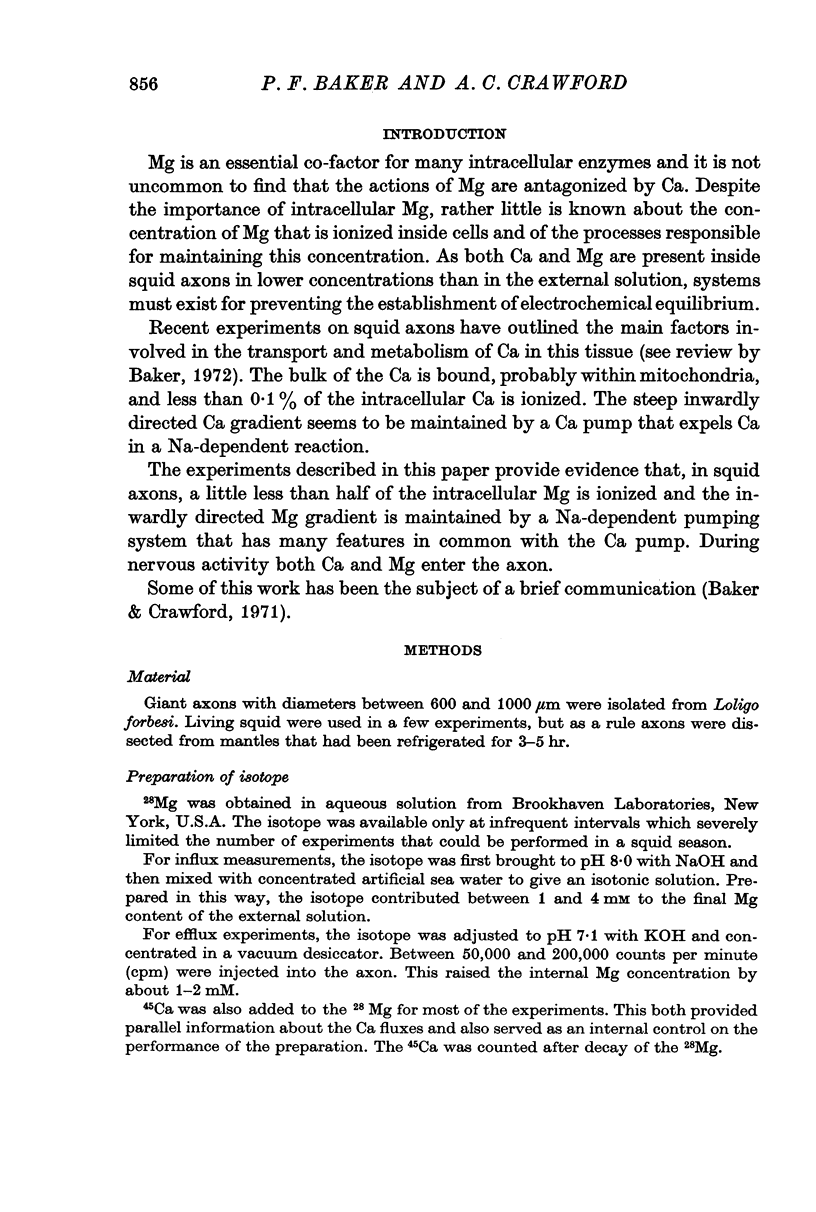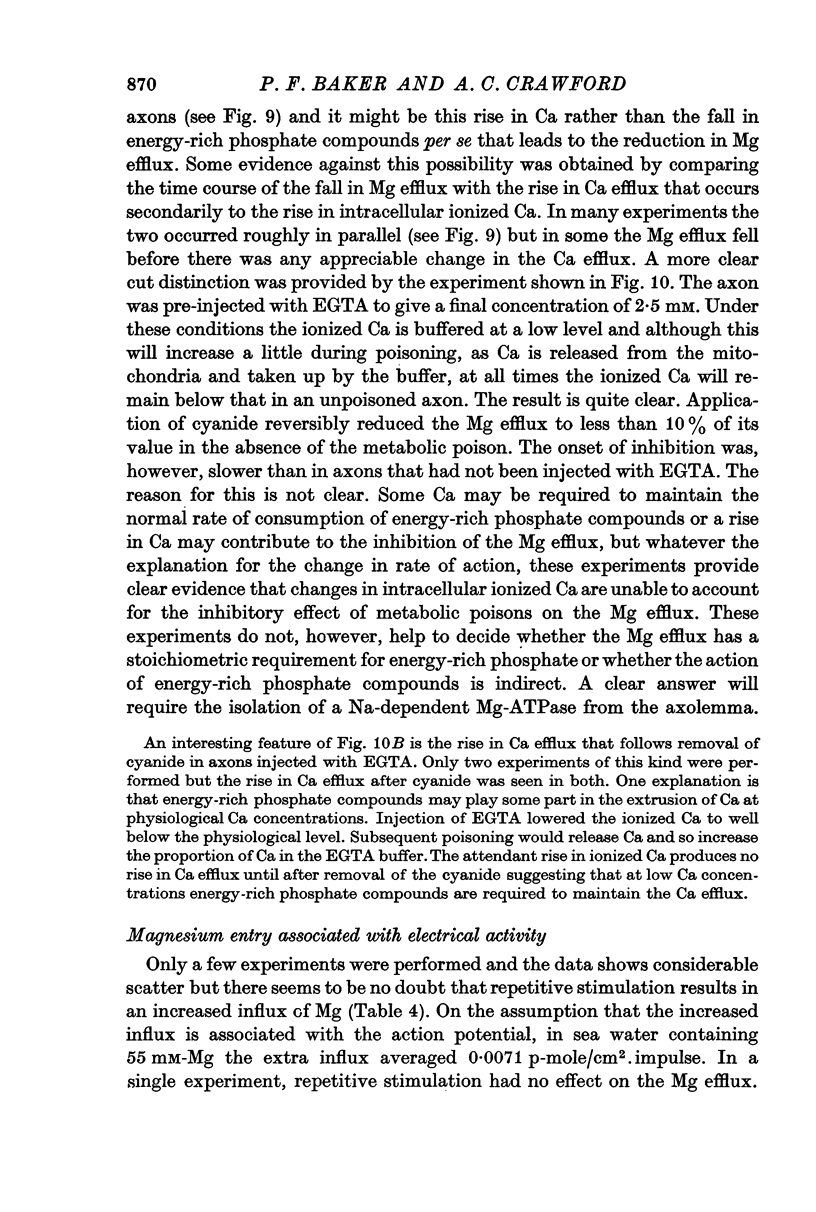Abstract
1. The Mg content of axons obtained from Loligo forbesi averaged 6·4 ± 0·8 m-mole/kg axoplasm.
2. A small patch of radioactive 28Mg injected into an axon broadened considerably. A similar patch of 45Ca showed hardly any broadening. The self-diffusion coefficient of Mg in axoplasm is about 2 × 10-6 cm2/sec which is at least twenty times greater than that of Ca.
3. Under the influence of an applied electric field Mg migrated towards the cathode. Its mobility was about half of that of Mg in free solution. This suggests that the concentration of ionized Mg in squid axoplasm is between 2 and 3 m-mole/kg axoplasm. The mobility of Mg was not changed by poisoning the axon fully.
4. Mg influx and Mg efflux were roughly the same and equal to about 1 p-mole/cm2 sec. Mg efflux was reduced by poisoning with cyanide and by replacement of external Na by choline. Removal of external K or Ca had little effect and removal of external Mg tended to increase the efflux.
5. The dependence of Mg efflux on Na seems not to be secondary to changes in Ca because it persists in the absence of external Ca and in axons pre-injected with EGTA. The form of the dependence on Na ions approximates to a simple rectangular hyperbola.
6. Replacement of external Na by Li or choline increased Mg influx. Mg influx was unaffected by cyanide.
7. Mg efflux was reduced to an average of 15% by poisoning with cyanide or DNP. The efflux could be recovered by injection of ATP. Inhibition persisted in axons pre-injected with EGTA, showing that it is not secondary to a rise in Cai.
8. During nervous activity there is an extra entry of Mg. For axons immersed in sea water this extra Mg entry per impulse is roughly the same as the extra Ca entry per impulse.
Full text
PDF



















Selected References
These references are in PubMed. This may not be the complete list of references from this article.
- Ashley C. C., Ellory J. C. The efflux of 28Mg from single muscle fibres. J Physiol. 1971 Mar;213(2):55P–56P. [PubMed] [Google Scholar]
- Ashley C. C., Ellory J. C. The efflux of magnesium from single crustacean muscle fibres. J Physiol. 1972 Nov;226(3):653–674. doi: 10.1113/jphysiol.1972.sp010002. [DOI] [PMC free article] [PubMed] [Google Scholar]
- Baker P. F., Blaustein M. P., Hodgkin A. L., Steinhardt R. A. The influence of calcium on sodium efflux in squid axons. J Physiol. 1969 Feb;200(2):431–458. doi: 10.1113/jphysiol.1969.sp008702. [DOI] [PMC free article] [PubMed] [Google Scholar]
- Baker P. F., Crawford A. C. Sodium-dependent transport of magnesium ions in giant axons of Loligo forbesi. J Physiol. 1971 Jul;216(1):38P–40P. [PubMed] [Google Scholar]
- Baker P. F., Hodgkin A. L., Ridgway E. B. Depolarization and calcium entry in squid giant axons. J Physiol. 1971 Nov;218(3):709–755. doi: 10.1113/jphysiol.1971.sp009641. [DOI] [PMC free article] [PubMed] [Google Scholar]
- Baker P. F., Shaw T. I. A comparison of the phosphorus metabolism of intact squid nerve with that of the isolated axoplasm and sheath. J Physiol. 1965 Sep;180(2):424–438. doi: 10.1113/jphysiol.1965.sp007710. [DOI] [PMC free article] [PubMed] [Google Scholar]
- Blaustein M. P., Hodgkin A. L. The effect of cyanide on the efflux of calcium from squid axons. J Physiol. 1969 Feb;200(2):497–527. doi: 10.1113/jphysiol.1969.sp008704. [DOI] [PMC free article] [PubMed] [Google Scholar]
- CALDWELL P. C. The phosphorus metabolism of squid axons and its relationship to the active transport of sodium. J Physiol. 1960 Jul;152:545–560. doi: 10.1113/jphysiol.1960.sp006508. [DOI] [PMC free article] [PubMed] [Google Scholar]
- HODGKIN A. L., KEYNES R. D. Movements of labelled calcium in squid giant axons. J Physiol. 1957 Sep 30;138(2):253–281. doi: 10.1113/jphysiol.1957.sp005850. [DOI] [PMC free article] [PubMed] [Google Scholar]


